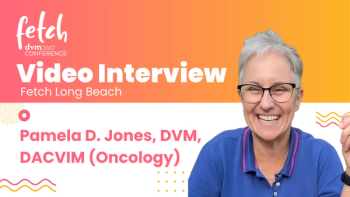
- dvm360 November 2023
- Volume 54
- Issue 11
- Pages: 36
Latest innovations and treatments in companion animal oncology
And how they are being used in conjunction with traditional treatments to produce the most successful outcomes
Cancer is the leading cause of death in adult dogs and adult cats,1,2 with 50% of canines and 30% of felines over age 10, respectively, dying from this disease.3
Traditional treatments for companion animal cancer have consisted of chemotherapy, radiation, and surgery. Though these therapies are well tolerated, to further address this epidemic and improve outcomes, innovations have primarily followed suit with human medicine, focusing on early detection, precision medicine, and a multimodal approach. Below are the latest diagnostic tools and treatments being leveraged in veterinary oncology:
Liquid biopsy
This non-invasive screening test can be used at routine wellness checks to detect if pets have cancer before any clinical signs even appear. It involves a simple blood draw from the animal and this sample is then sent to a lab where the cell-free DNA is processed.4 It is analyzed for mutations that can indicate if it is healthy or cancerous.
In a dvm360
If it detects cancer, a liquid biopsy is not enough to determine the cancer type and location. Further testing must take place (eg, imaging, X-rays, ultrasound) to reveal this information.4 Liquid biopsy tests help promote early detection, so treatment can be implemented while the cancer is at its early stages for the most successful outcomes.
Two liquid biopsy tests currently available to detect canine cancer are Nu.Q by Volition Veterinary in partnership with Heska and OncoK9 by PetDx.5
Targeted therapy
When cancer is confirmed in a pet, targeted therapy serves as an innovative treatment option. While chemotherapy targets all rapidly dividing cells whether they are healthy or cancerous, targeted therapy is directed at certain molecular targets associated with cancer.6 Thus, targeted therapies are less toxic to healthy cells than chemotherapy. However, like chemotherapy, targeted therapy can be used in conjunction with additional treatments such as surgery or radiation.
Two targeted therapies currently available on the veterinary market include toceranib phosphate (Palladia; Pfizer) and verdinexor (Laverdia-CA1; Dechra) .6
Immunotherapy
The premise of immunotherapy is boosting the pet’s immune system, so it can fight the cancer itself more effectively. Though cancer cells can be identified as foreign invaders by the immune system, they can slip from detection or can multiply too rapidly for the immune system to react.4,7
Immunotherapy teaches an animal’s immune system to identify cancer, and then attack it. This can be achieved by using anything from autologous cancer vaccines created uniquely based on the specific pet’s tumor to checkpoint inhibitors that block proteins that prevent the immune system from fighting cancerous cells.4,7
This treatment is most effective with a smaller “cancer load,” meaning when used after chemotherapy, radiation, and surgery have first shrunk the cancer. 7
"There are lots of data out there that show that combining immunotherapy with chemotherapy for example, or immunotherapy with other types of immunotherapy may, in fact, provide a better result," stated Michael D. Lucroy, DVM, MS, DACVIM (Oncology), chief medical officer of Torigen Inc, in a dvm360
"So, the notion of chemotherapy being immunosuppressive is kind of the way we used to think about things. But as we learn more, we find out that chemotherapy can actually have some positive effects on the immune system and combine nicely with things like cancer vaccines and combining cancer vaccines with checkpoint inhibitors. Things like that, I think will hold a lot of promise for us," he added.
Takeaways
The latest breakthroughs in veterinary oncology include taking a proactive approach through early screening and providing personalized treatment with precision medicine. Conventional surgery, chemotherapy, and radiation treatments are still widely used and effective and often work in conjunction with the newest cancer therapies for the most successful outcomes.
"One of our guiding tenets of managing cancer patients is the idea of multimodal therapy. So any one thing can help, but when you do more than one thing, you get better results. And perhaps if you do all the things, you get an outstanding result," Lucroy said in the
References
- Fleming JM, Creevy KE, Promislow DE. Mortality in North American dogs from 1984 to 2004: an investigation into age-, size-, and breed-related causes of death. J Vet Intern Med. 2011;25(2):187-98. doi: 10.1111/j.1939-1676.2011.0695.x
- Kent MS, Karchemskiy S, Culp WTN, et al. Longevity and mortality in cats: a single institution necropsy study of 3108 cases (1989-2019). PLoS One. 2022;17(12):e0278199. doi: 10.1371/journal.pone.0278199
- Beltrán Hernández I, Kromhout JZ, Teske E, Hennink WE, van Nimwegen SA, Oliveira S. Molecular targets for anticancer therapies in companion animals and humans: what can we learn from each other? Theranostics. 2021;11(8):3882-3897. doi: 10.7150/thno.55760
- Gibeault S. New groundbreaking innovations in canine cancer. American Kennel Club. Published July 20, 2022. Updated July 21, 2022. Accessed August 16, 2023. https://www.akc.org/expert-advice/health/innovations-in-canine-cancer
- Manhombo T. New liquid biopsy cancer screening for dogs explained. The National Canine Cancer Foundation. February 2, 2023. Accessed August 16, 2023. https://wearethecure.org/liquid-biopsy-for-dogs
- Precision medicine: Could this transform the way we treat dogs with cancer? MedVet. Accessed August 16, 2023. https://www.medvet.com/precision-medicine-could-this-transform-the-way-we-treat-dogs-with-cancer
- Immunotherapy treatment. Cornell University College of Veterinary Medicine. Accessed August 16, 2023. https://www.vet.cornell.edu/departments-centers-and-institutes/riney-canine-health-center/canine-health-information/immunotherapy-treatment
Articles in this issue
about 2 years ago
Shocked? Extracorporeal shockwave therapy offers many benefitsabout 2 years ago
Holiday gift ideas for pets and professionalsabout 2 years ago
Enrichment never gets old: Why senior pets need stimulation tooabout 2 years ago
How to leverage allyship to create more inclusive culturesabout 2 years ago
Is your practice seeing enough senior pets?about 2 years ago
The spectrum of care with Emily M. Tincher, DVMabout 2 years ago
Hire attitude and gratitude...train aptitude!about 2 years ago
Nonpharmacologic management of canine osteoarthritis: Part 1Newsletter
From exam room tips to practice management insights, get trusted veterinary news delivered straight to your inbox—subscribe to dvm360.






